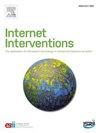一起做:角色间冲突双向互联网干预的障碍和促进因素的定性研究
IF 4.1
2区 医学
Q1 HEALTH CARE SCIENCES & SERVICES
Internet Interventions-The Application of Information Technology in Mental and Behavioural Health
Pub Date : 2025-10-03
DOI:10.1016/j.invent.2025.100880
引用次数: 0
摘要
一些社会心理挑战具有内在的相关性,采用双干预比单独干预更有效。尽管对互联网干预的吸收和参与已经进行了广泛的研究,但现有的证据主要集中在以个人为导向的计划上,这使得它们潜在的二元现象——如工作-家庭冲突(WFC)和家庭-工作冲突(FWC)——在很大程度上没有得到探索。为了确定旨在减少角色间冲突的二元互联网干预的障碍和促进因素,我们对20对双收入异性恋夫妇(N = 40)进行了半结构化访谈。专题分析揭示了与可能参与这种干预有关的五个关键主题。服用的动机与认识到的需要、好奇心和对疗效的信念有关。让双方都参与进来会带来关系上的好处,但也会带来安排上的困难,突出了“一起做”的挑战。参与者对在网上披露个人信息感到矛盾,在分享意愿上存在微妙的性别差异。他们还强调了灵活、引人入胜和个性化教学设计的重要性。最后,参与者对在线形式的看法是矛盾的——虽然时间限制经常增加,但访问的灵活性往往减轻了时间限制。这些发现表明,有效的WFC/FWC二元互联网干预必须平衡个人和联合活动,纳入对性别敏感的沟通途径,并根据不同的夫妇情况(例如,有孩子或没有孩子)量身定制内容。这种努力可提高参与和执行的可行性。本文章由计算机程序翻译,如有差异,请以英文原文为准。
Doing it together: Qualitative study on barriers and facilitators to dyadic internet interventions for interrole conflict
Some psychosocial challenges are inherently relational and may be addressed more effectively with dyadic rather than individual interventions. Although uptake and engagement of internet interventions have been widely studied, existing evidence focuses on individually oriented programmes, leaving their potential for dyadic phenomena—such as work–family conflict (WFC) and family–work conflict (FWC)—largely unexplored. To identify barriers and facilitators specific to a dyadic internet intervention aimed at reducing interrole conflict, we conducted semi-structured interviews with 20 heterosexual, dual-earner couples (N = 40). Thematic analysis revealed five key themes related to potential participation in such an intervention. Motivation for uptake was tied to recognized need, curiosity, and belief in efficacy. Involving both partners promised relational benefits yet introduced scheduling difficulties, highlighting the challenge of “doing it together.” Participants felt ambivalent about disclosing personal matters online, with subtle gendered differences in willingness to share. They also emphasized the importance of flexible, engaging, and personalized pedagogical design. Finally, participants viewed the online format ambivalently—while time constraints were often raised, they were frequently mitigated by the flexibility of access. These findings suggest that effective dyadic internet interventions for WFC/FWC must balance individual and joint activities, incorporate gender-sensitive communication pathways, and tailor content to different couple profiles (e.g., with or without children). Such efforts may enhance engagement and implementation feasibility.
求助全文
通过发布文献求助,成功后即可免费获取论文全文。
去求助
来源期刊

Internet Interventions-The Application of Information Technology in Mental and Behavioural Health
Medicine-Health Informatics
CiteScore
6.50
自引率
9.30%
发文量
94
审稿时长
6 weeks
期刊介绍:
Official Journal of the European Society for Research on Internet Interventions (ESRII) and the International Society for Research on Internet Interventions (ISRII).
The aim of Internet Interventions is to publish scientific, peer-reviewed, high-impact research on Internet interventions and related areas.
Internet Interventions welcomes papers on the following subjects:
• Intervention studies targeting the promotion of mental health and featuring the Internet and/or technologies using the Internet as an underlying technology, e.g. computers, smartphone devices, tablets, sensors
• Implementation and dissemination of Internet interventions
• Integration of Internet interventions into existing systems of care
• Descriptions of development and deployment infrastructures
• Internet intervention methodology and theory papers
• Internet-based epidemiology
• Descriptions of new Internet-based technologies and experiments with clinical applications
• Economics of internet interventions (cost-effectiveness)
• Health care policy and Internet interventions
• The role of culture in Internet intervention
• Internet psychometrics
• Ethical issues pertaining to Internet interventions and measurements
• Human-computer interaction and usability research with clinical implications
• Systematic reviews and meta-analysis on Internet interventions
 求助内容:
求助内容: 应助结果提醒方式:
应助结果提醒方式:


